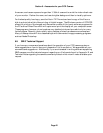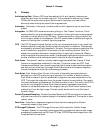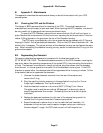
Section 8 - Glossary
Page 47
Planet Mode - Planet Mode is the most useful way to achieve focus. When you select Planet
mode, a full frame is exposed, downloaded, and displayed on the computer monitor. A
small window can be placed anywhere in the image area and the size of the window
can be changed. Subsequent downloads will be of the area inside the box resulting in a
much faster update rate.
Quantum Efficiency - Quantum Efficiency refers to the fractional number of electrons formed
in the CCD pixel for a given number of photons. Quantum Efficiency is usually plotted
as a function of wavelength.
Readout Noise - Readout noise is associated with errors generated by the actual interrogation
and readout of each of the CCD pixels at the end of an exposure. This is the result of
fixed pattern noise in the CCD, residual charge in the readout capacitors and to a small
extent the noise from the A/D converter and preamplifier.
Resolution Mode - The resolution of a CCD camera is determined by pixel size. Pixel size can
be increased by combining or binning more than one pixel and displaying it as one
pixel. Doing so decreases the effective resolution but speeds up the download time of
the image. Maximum resolution is determined by the size of the individual CCD pixel.
The ST-7E/8E/9E can run in High, Medium, Low and Auto resolution modes.
Response Factor - Response Factor is a multiplier used by CCDOPS to calibrate CCDOPS to a
given telescope for photometric calculations. The Response Factor multiplied by 6700 is
the number of photoelectrons generated in the CCD for a 0th magnitude star per second
per square inch of aperture.
Saturation - Saturation refers to the full well capacity of a CCD pixel as well as the maximum
counts available in the A/D converter. The pixel is saturated when the number of
electrons accumulated in the pixel reaches its full well capacity. The A/D is saturated
when the input voltage exceeds the maximum. The saturation values for the various
cameras are shown in the table below.
Camera
Full Well
Capacity
Maximum
A/D
Counts
Electrons
per A/D
count
8
ST-5C 50,000 e- 65,535 1.25
ST-237 20,000 e- 4,095 3.4
ST-237A 20,000 e- 65,535 0.7
ST-6 400,000 e- 65,535 6.7
ST-7E/ST-8E
9
ABG High Res 50,000 e- 20,000 2.3
ST-7E/ST-8E Med/Low Res 100,000 e- 65,535 2.3
ST-7E/8E/9E/10E Tracking CCD 150,000 e- 65,535 1.3
ST-9E 180,000 e- 65,535 2.8
ST-10E 77,000 e- 65,535 1.5
ST-1001E 180,000e- 65,535 2.8
8
The e
-
/Count shown are for the High Resolution readout mode. These numbers can be different for other
readout modes. Use the Parameters command in the Display menu to see the actual value for images acquired
in other readout modes.
9 The non-ABG versions of the ST-7E/8E have twice the full well capacity of the values shown. ABG version
may also vary from camera to camera with maximum counts being as high as ~30,000.


















